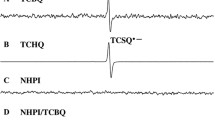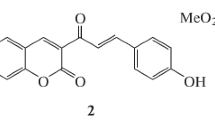Summary
Benzoyl peroxide catalytic decomposition of carbon tetrachloride in a model system produces trichloromethyl and trichloromethylperoxyl free radicals. These radicals are also produced by CCl4 bioactivation in liver and are considered to be responsible for the deleterious effects of this hepatotoxin. In this study, it is attempted to learn about how the .CCl3 and CCl3O2. tend to react with hydroxyproline in a model system. Hydroxyproline was selected because of its role in collagen metabolism. During the interaction of both radicals with hydroxyproline a total of 16 reaction products were isolated and identified by gas chromatographic-mass spectrometric analysis. All of them were hydroxyproline analogs, no single one contained C from CCl4 and only three contained chlorine. Consequently, most adducts would be missed in experiments where formation of reaction products are studied by formation of14C or36Cl labeled adducts (e.g. covalent binding studies used by toxicologists). If similar hydroxyproline analog reaction products were observed during CCl4 intoxication it might be reasonably expected that they interfered with collagen metabolism and participate in cirrhogenic effects of CCl4 on the liver.
Similar content being viewed by others
References
Ansari GA, Moslen MT, Reynolds ES (1982) Evidence for in vivo covalent binding of CCl3 derived from CCl4 to cholesterol of rat liver. Biochem Pharmacol 31: 3509–3510
Bedossa P, Houglum K, Trantwein C, Holstege A, Chojkier M (1994) Stimulation of collagen alpha 1 gene expression is associated with lipid peroxidation in hepatocellular injury: a link to tissue fibrosis? Hepatology 19: 1262–1271
Bolarin DM, Barker K, Fuller GC (1987) Enzyme markers of collagen synthesis in carbon tetrachloride-induced fibrosis and during colchicine modification of CCl4-induced liver injury. Exptl Mol Pathol 46: 145–152
Camps J, Bargallo T, Gimenez A, Alie J, Caballerìa J, Pares A, Joven J, Masana L, Rodes J (1992) Relationship between hepatic lipid peroxidation and fibrogenesis in carbon tetrachloride-treated rats: effects of zinc administration. Clin Sci 83: 695–700
Castro GD, Castro JA (1993) Cytosine attack by free radicals arising from bromotrichloromethane in the presence of benzoyl peroxide catalyst. A mass spectrometric study. Terat Carcing Mutag 13: 235–245
Castro GD, Díaz Gómez MI, Castro JA (1989a) Species differences in the interaction between CCl4 reactive metabolites and liver DNA and nuclear protein fractions. Carcinogenesis 10: 289–294
Castro GD, Díaz Gómez MI, Castro JA (1989b) Dimethyldisulfide formation during trichloromethyl radicals attack on methionine. Biochem Pharmacol 38: 4145–4147
Castro GD, Díaz Gómez MI, Castro JA (1991) Interaction of trichloromethyl free radicals with phenylalanine. Arch Toxicol 65: 340–343
Castro GD, Simpson JT, Castro JA (1994a) Interaction of trichloromethyl free radicals with thymine in a model system. A mass spectrometric study. Chem Biol Int 90: 13–22
Castro GD, Stamato CJ, Castro JA (1994b) Tyrosine attack by free radicals derived from catalytic decomposition of carbon tetrachloride. Free Rad Biol Med 16: 693–701
Castro GD, Stamato CJ, Castro JA (1995) Proline interaction with trichloromethyl and trichloromethylperoxyl free radicals in a model system. Studies about the nature of the reaction products formed. Drug Met Rev 27: 257–275
Castro JA (1984) Mechanistical studies and prevention of free radical cell injury. Proc 9th (IUPHAR) Intl Congress Pharmacol 2. MacMillan Press Ltd., London, pp 243–250
Castro JA (1990) Prevention of chemically induced liver injury. In: Goldstein RS, Hewitt W, Hook JB (eds) Toxic interactions between chemicals. Mechanisms and effects. Academic Press, New York, pp 233–257
Chofkier M, Lyche KD, Filip M (1988) Increased production of collagen in vivo by hepatocytes and nonparenchymal cells in rats with carbon tetrachloride-induced hepatic fibrosis. Hepatology 8: 808–814
Darnell J, Lodish H, Baltimore D (1986) Molecular cell biology. Scientific American Books, Inc., New York, pp 973–977
de Castro CR, Bernacchi AS, Villarruel MC, Fernández G, Castro JA (1984) Carbon tetrachloride activation by highly purified liver mitochondrial preparations. Agents Actions 15: 664–667
Dean RT, Wolff SP, Mc Elligott MA (1989) Histidine and proline are important site of free radical damage to proteins. Free Rad Res Commun 7: 97–103
Dianzani MU (1987) The role of free radicals in liver damage. Proc Nut Soc 46: 43–52
Díaz Gómez MI, Castro JA (1980) Covalent binding of carbon tetrachloride metabolites to liver nuclear DNA, proteins and lipids. Toxicol Appl Pharmacol 56: 199–206
Díaz Gómez MI, Castro JA (1981) Reaction of trichloromethyl free radicals with deoxyribonucleic acid bases. Res Commun Chem Pathol Pharmacol 32: 147–153
Ehrinpreis MN, Giambrone MA, Rojkind M (1980) Liver proline oxidase activity and collagen synthesis in rats with cirrhosis induced by carbon tetrachloride. Biochim Biophys Acta 629: 184–193
Fernández G, Villarruel MC, de Toranzo EGD, Castro JA (1982) Covalent binding of carbon tetrachloride metabolites to the heme moiety of cytocrome P450 and its degradation products. Res Commun Chem Pathol Pharmacol 35: 282–290
Frank H, Thiel D, MacLeod J (1989) Mass spectrometric detection of cross-linked fatty acids formed during radical-induced lesion of lipid membranes. Biochem J 260: 873–878
Galligani L, Lonati-Galligani M, Fuller G (1979) Collagen metabolism in the liver of normal and carbon tetrachloride-treated rats. Biomedicine 31: 199–201
Gaudio E, Pannarale L, Franchitto AQ, Riggio O (1993) Zinc supplementation in experimental liver cirrhosis: a morphological structural and structural study. Int J Exptl Pathol 74: 463–469
IARC (1979) IARC monographs on the evaluation of the carcinogenic risk of chemicals to humans. Some halogenated hydrocarbons, vol 20. Lyon, pp 371–389
Lindblad WJ, Fuller GC (1989) Hepatic collagenase activity during carbon tetrachloride induced fibrosis. Fund Appl Toxicol 3: 34–40
Martinez-Hernandez A (1985) The hepatic extracellular matrix II. Electron inmunohistochemical studies in rats with CCl4-induced cirrhosis. Lab Invest 53: 166–186
McGee JOD, O'Hare RP, Patrick RS (1973) Stimulation of collagen biosynthetic pathway by factors isolated from experimentally injured liver. Nature 243: 121–123
Montfort I, Perez-Tamayo R (1978) Collagenase in experimental carbon tetrachloride cirrhosis of the liver. Am J Pathol 92: 411–418
Mourelle M, Muriel P, Favari L, Franco T (1989) Prevention of carbon tetrachloride-induced liver cirrhosis by silymarin. Fundam Clin Pharmacol 3: 183–192
Murawaki Y, Yamamoto H, Koda M, Kawasaki H (1994) Serum collagenase activity reflects the amount of liver collagenase in chronic carbon tetrachloride-treated rats. Res Commun Chem Pathol Pharmacol 84: 63–72
Myara I, Miech G, Fabre M, Mangeot M, Lemonnier A (1987) Changes in prolinase and prolidase activity during CCl4 administration inducing liver cytolysis and fibrosis in rat. Br J Exptl Pathol 68: 7–13
Okazaki I, Mamyama K (1974) Collagenase activity in experimental hepatic fibrosis. Nature 252: 49–50
Perez-Tamayo R (1979) Cirrhosis of the liver. A reversible disease? Pathol Ann 14: 183–213
Recknagel RO (1967) Carbon tetrachloride hepatotoxicity. Pharmacol Rev 19: 145–208
Recknagel RO, Glende EA, Dolak JA, Walter RL (1986) Mechanisms of carbon tetrachloride toxicity. Pharmacol Ther 43: 139–154
Rojkind M (1982a) The extracellular matrix. In: Arias I, Popper H, Schachter D, Shafritz DA (eds) The liver: biology and pathobiology. Raven Press, New York, pp 537–548
Rojkind M (1982b) Fibrogenesis. In: Arias I, Popper H, Schachter D, Shafritz DA (eds) The liver: biology and pathobiology. Raven Press, New York, pp 801–809
Sakaida I, Kubota M, Kayano K, Takenaka K, Mori K, Okita K (1994) Prevention of fibrosis reduces enzyme-altered lesions in the rat liver. Carcinogenesis 15: 2201–2206
Seigert WF, Bosma A, Bronwer A, Hendriks HF, Roholl PS, Van Leeuwen RE, Van Thied de Renter GC, Seifert-Bock I, Knook DL (1994) Vitamin A deficiency potentiates carbon tetrachloride-induced liver firbrosis in rats. Hepatol 19: 193–201
Siegel RC, Chen KH, Greenspan JS, Aguiar JM (1978) Biochemical and inmunochemical study of lysyl oxidase in experimental hepatic fibrosis in the rat. Proc Natl Acad Sci (USA) 75: 2945–2949
Slater TF (1982) Activation of carbon tetrachloride: chemical principles and biological significance. In: McBrien DCH, Slater TF (eds) Free radicals, lipid peroxidation and cancer. Academic Press, New York, pp 243–274
Uchida K, Kato Y, Kawakishi S (1990) A novel mechanism for oxidative cleavage of prolyl peptides induced by the hydroxyl radical. Biochem Biophys Res Commun 169: 265–271
USEPA (1983) Health assessment document for carbon tetrachloride. EPA 600/8-82-001, Washington DC
Vanaja R, Gajalakshmi BS (1993) Zinc counteracts experimentally-induced cirrhotic changes in rats. Indian J Physiol Pharmacol 37: 163–164
Villarruel MC, Castro JA (1980) Reactions of trichloromethyl free radicals with amino acids. Res Commun Chem Pathol Pharmacol 28: 79–85
Yamane M, Tanaka Y, Marumo F, Sato C (1993) Role of hepatic Vitamin A and lipocyte distribution in experimental hepatic fibrosis. Liver 13: 282–287
Author information
Authors and Affiliations
Rights and permissions
About this article
Cite this article
Castro, G.D., Castro, J.A. Hydroxyproline reaction with free radicals generated during benzoyl peroxide catalytic decomposition of carbon tetrachloride Structure of reaction products formed. Amino Acids 10, 283–294 (1996). https://doi.org/10.1007/BF00807331
Received:
Accepted:
Issue Date:
DOI: https://doi.org/10.1007/BF00807331




